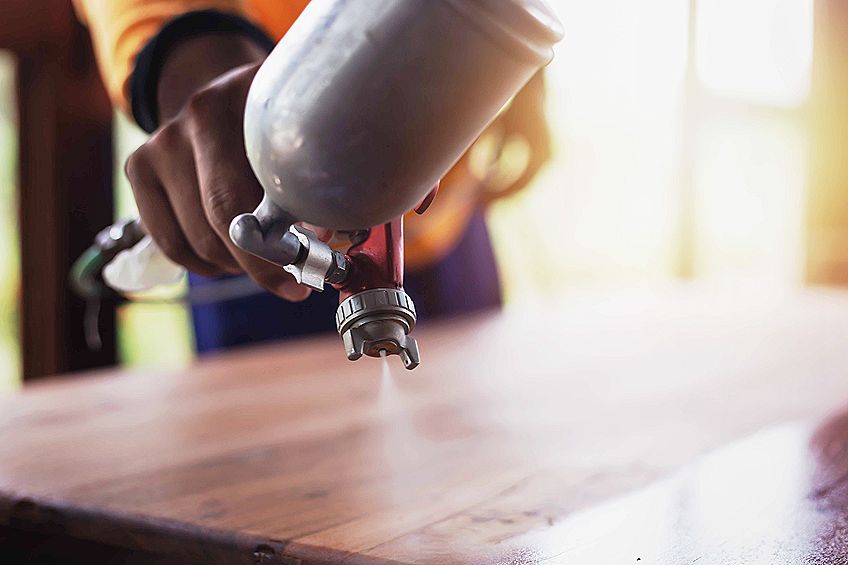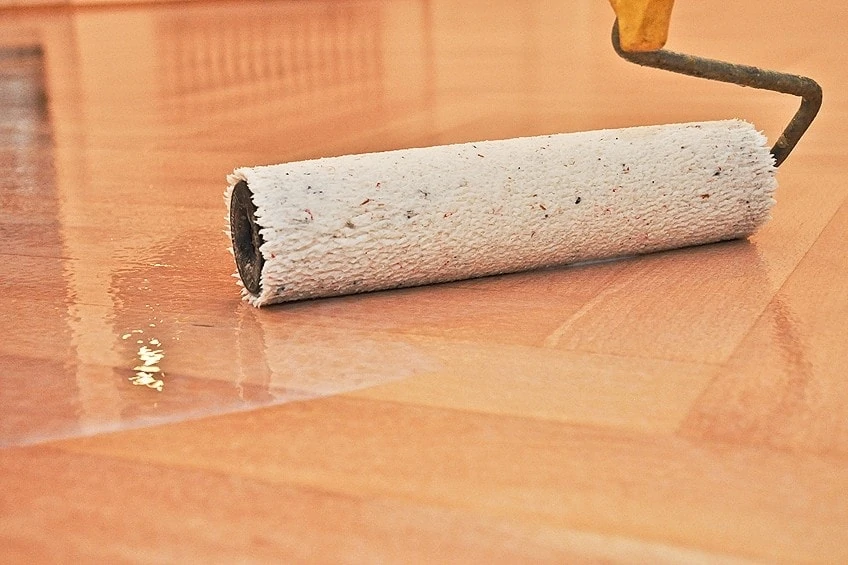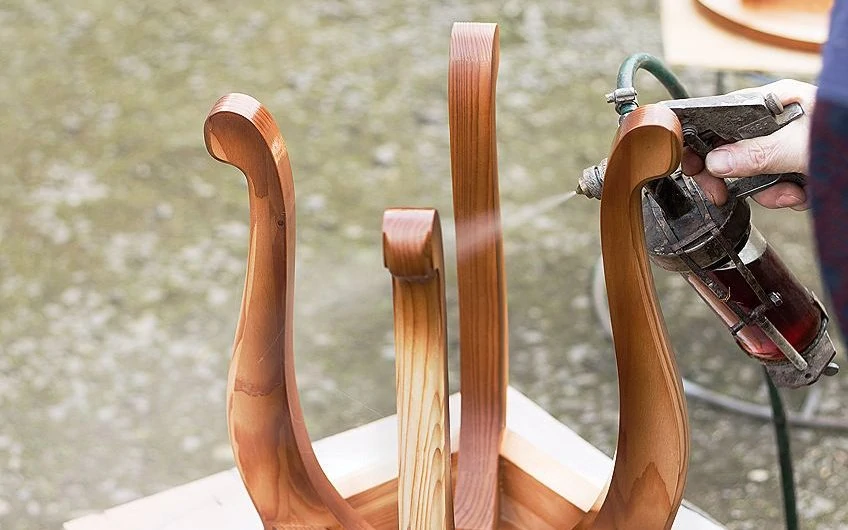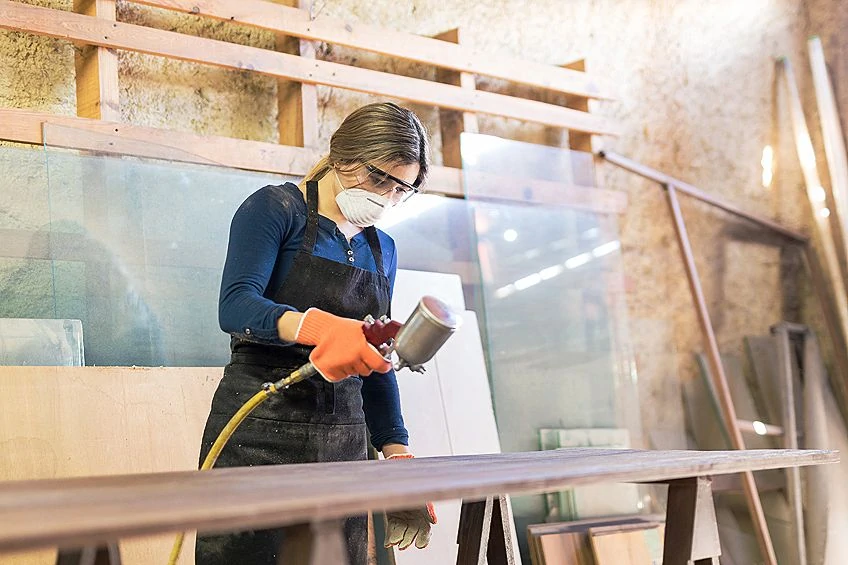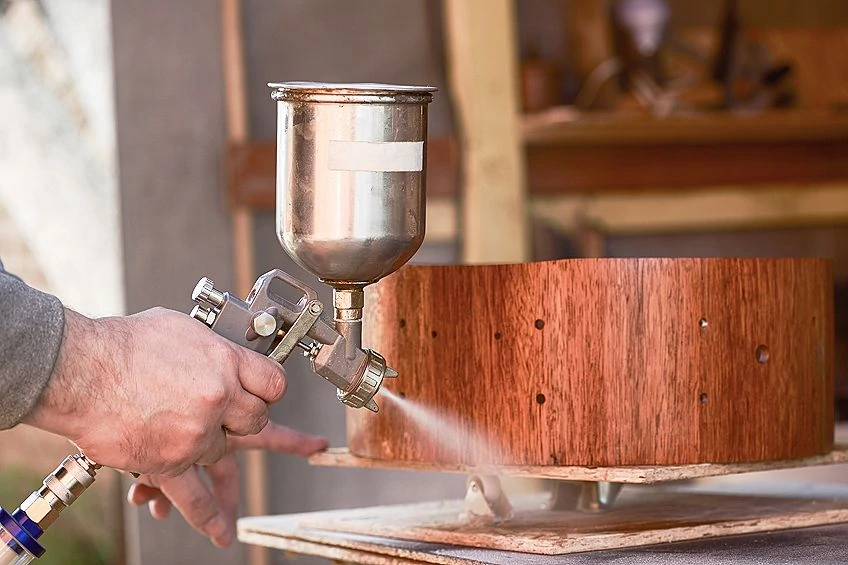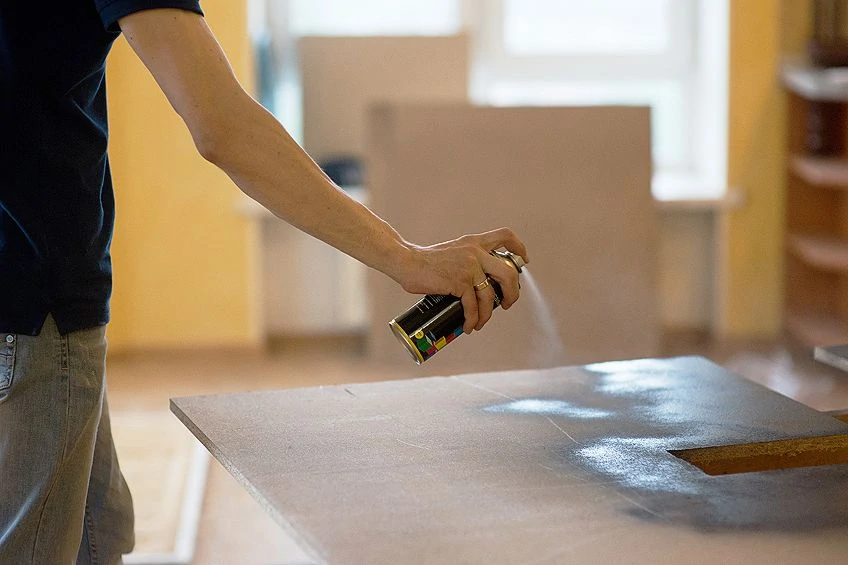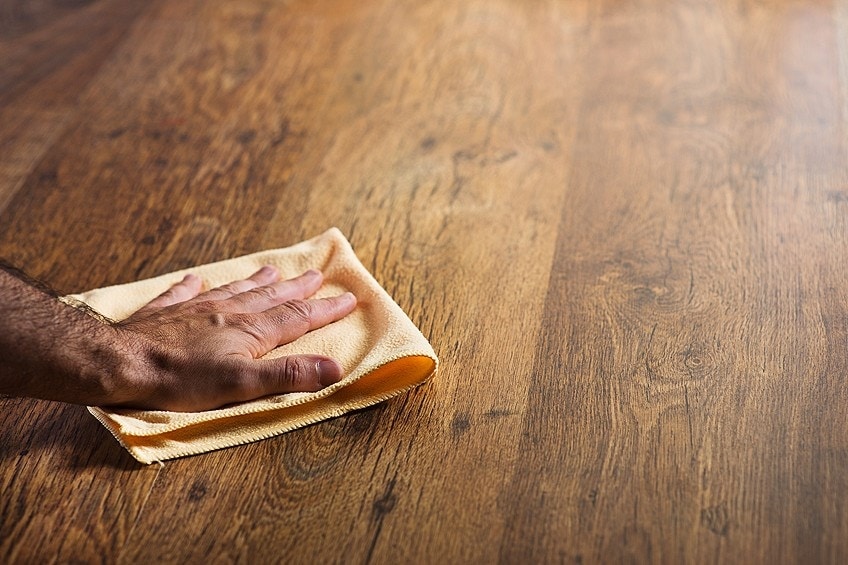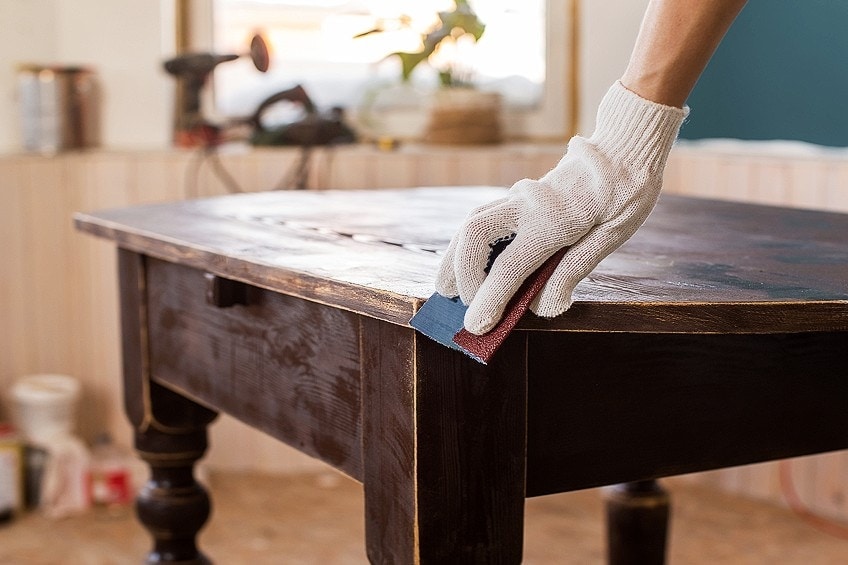Best Wood Lacquer – Tutorial for Spray and Paint Lacquer for Wood
This post may contain affiliate links. We may earn a small commission from purchases made through them, at no additional cost to you. You help to support resin-expert.com
When working with wood, you will want to end the project with a smooth and shiny finish over the wood. This is when you should look towards lacquer and varnish. The best wood lacquer will provide a long-lasting glossy shine to the wood that will help to protect the wooden surface. Lacquer dries fast, is easy to use, and can be sprayed or painted onto wood. Instead of wood oil that soaks into the wood, using a wood lacquer spray will provide a strong outer coating. Read on if you want to discover everything there is to know about lacquer paint for wood, how to use it, and which products are best.
Table of Contents
Wood Lacquer vs. Varnish
Wood lacquer and varnish are similar coatings that are often confused with each other. A lacquer paint for wood is a type of finish that is solvent-based. It provides a protective coating over wood and metal. Lacquers are made up of plasticizers, dissolved nitrocellulose, and color pigments. In terms of offering a protective coating over wooden surfaces, wood lacquers are usually more effective when compared to varnish.
Both varnish and wood lacquer offers an attractive shiny surface. Varnish is usually clear while wood lacquer is available in a range of different colors and sheen options. You can get clear lacquer for wood, as well as different finish options (matte, high-gloss, and so on).
Spray lacquer for wood is available in a user-friendly can, or in a paint or rub on version. You can also get spray varnish for wood, but varnish is usually painted over due to its thicker consistency. The best wood lacquer is pretty thin, making it faster to dry when compared to varnish. Using the best wood lacquer offers many unique advantages, and is often the first choice for people looking for a strong finish to coat over wood.
Wood Lacquer or Polyurethane
In addition to wood lacquer and varnish, you can also get polyurethane sealants for wood. Polyurethane is not as easy to work with as wood lacquer, and it requires some extra precision. Wood lacquer is faster-drying and easier to maintain and fix compared to polyurethane. The best wood lacquer can also be used over various other surfaces, such as metal. Polyurethane and wood lacquer are not compatible with each other, so they cannot be used on the same surface.
Although polyurethane takes longer to dry and is more difficult to work with, it does also offer a stronger, more durable finish. Lacquer can yellow over time and is not always resistant to scratches. However, you can apply many coats of wood lacquer with far greater ease than polyurethane coats.
Why Should You Use Wood Lacquer?
Wood lacquer spray is a very useful finish that offers numerous benefits. This type of finish can be used on a wide range of wood surfaces ad projects – providing a versatile solution that offers top results. There are many different wood lacquer options out there, so always be careful when choosing the best wood lacquer for your specific project.
Pros
- Lacquer is fast-drying which makes it easier to work with. This also helps to prevent runs and drips
- Easy to achieve a smooth and even coating
- You only need a small amount of wood lacquer to produce a stunning glossy shine
- There are various color and sheen options available
- You can easily polish lacquered surfaces for greater shine
- An affordable option for sealing wood
- Lacquer also has waterproofing properties which make it a good choice as a sealant
- Easy to maintain
- It can easily be thinned for creating a wood lacquer spray
Cons
- Multiple layers are needed for a good finish as the coats of lacquer are thin
- Lacquer is not heat resistant and can damage under too much sun or heat exposure
- Lacquer can yellow over time. This is particularly true for nitrocellulose lacquers
- Flammable and often toxic
- Lacquers can produce potent fumes
- Not scratch-resistant
- Lacquer is prone to getting quite dusty/dirty and may require regular cleaning
- Not the best choice as an outdoor wood finish
When choosing the best wood lacquer, there are various benefits and drawbacks. With the different types of finishes and brands available, the type of lacquer you choose should be based on the type of effect you are after. Always consider the different types of paints lacquers available before choosing a particular product.
Different Lacquer Paint for Wood Options
In order to find the best wood lacquer, you will need to know what options are available. Lacquer comes in a variety of different forms for different uses. There are three main types of wood lacquer available which are acrylic lacquers, nitrocellulose lacquers, and catalyzed lacquers. Let’s explore these in more detail below.
Nitrocellulose Lacquers
Nitrocellulose lacquers have been used in various different industries and applications for a long time. This type of lacquer is formulated with nitrocellulose dissolved into a base of solvents. This is combined with plasticizers for greater strength and flexibility. This type of lacquer can be colored with pigments or dyes. It is fast drying and versatile.
Nitrocellulose is similar to shellac except that it is more durable. The only downside to this type of lacquer is that it is flammable and solvent-based which means that it can be quite toxic. Nitrocellulose lacquers also have a tint to them which is not always suitable for the type of wood you are working with. Other disadvantages to nitrocellulose lacquers are that they can yellow over time, they can crack, and they dont offer great protection against chemicals and abrasions.
Acrylic Lacquers
Acrylic lacquer is a great choice for both woods and metals – particularly on cars. This type of lacquer consists of acrylic polymers which make it dry as a clear lacquer for wood. This means that it is a popular choice for anyone working with lighter woods. Compared to nitrocellulose lacquer, this type won’t result in any yellowing, and it offers a better level of scratch resistance.
Within this style of lacquer, you can get CAB-Acrylic lacquers. These contain cellulose acetate butyrate which is a form of thermoplastic that is transparent. For greater flexibility and strength there are is also acrylic resin.
Catalyzed Lacquers
A catalyzed lacquer is a form of your typical wood lacquer that hardens when the solvent in it evaporates after application. These types of lacquers contain a solvent evaporation process for drying, as well as a chemical curing catalyst. Catalyzed lacquers are more durable and offer a wide range of benefits. They are available in the form of a pre or post-catalyzed lacquer.
Pre-catalyzed or post-catalyzed is how the product comes when bought. If pre-catalyzed, the catalyst is already added to the lacquer by the manufacturer. This will have a slightly limited pot life. You can also get post-catalyzed lacquers that require you to mix in the catalyst yourself. This will require some precision.
Another style of lacquer is also available called waterborne lacquer. This is a more environmentally friendly and safe to use product. However, waterborne lacquer is not as durable.
The Best Wood Lacquer
If you are going ahead with a project involving wood, finishing it off with the best wood lacquer adds plenty of benefits. However, with so many different products and styles of lacquer available, finding the right one for your needs can be a challenge. We have selected some of the best wood lacquer products out there to help you achieve the best possible results.
Best Spray Lacquer for Wood: RUST-OLEUM Clear Gloss Lacquer Spray
If you are after the ideal wood lacquer spray, then this option by Rust-Oleum offers a smart solution. The spray is great for providing a durable high-sheen surface across irregular shaped items. You wont get any drip or brush marks, and can apply a smooth and even coat each time.
- Ideal for use on interior/exterior surfaces for a smooth, ultra-gloss finish
- Acrylic formula offers an ultra-hard, lustrous finish with fast curing time
- Durable coating can sanded and recoated for a higher gloss finish
This spray lacquer for wood dries to a clear finish and can be used on a wide range of different surfaces. These include wood, metal, plaster, masonry, or unglazed ceramics. Each can should cover an area of seven square feet, and it takes about 20 minutes for each coat to dry to touch. This clear coat spray for wood finish can also be sanded and reapplied for a shinier effect.
Pros
- Dries to a strong and durable finish
- Fast-drying
- Has a clear and shiny finish
- Easy to use
Cons
- The acrylic nature of this lacquer requires protective gear
- Not suitable for very large surfaces
- Overspray is a possibility
This lacquer ticks all the right boxes. It cures to an attractive finish, has a good level of durability, and is very user friendly. Despite the smaller size, you can use this lacquer for a wide range of applications.
Best Satin Spray Lacquer for Wood: DEFT Interior Clear Lacquer
This is a pure nitrocellulose lacquer that can be used on a wide range of interior surfaces – including wood and metal. This wood lacquer spray has a self-leveling formula which makes it easy to get a perfectly smooth finish over various objects. The spray is very user-friendly and takes about two hours to dry.
- Dries Crystal Clear In 30 Minutes, Non-Yellowing
- 100-Percent nitrocellulose brushing spray for most interior wood and metal surfaces
- Easy to application provide professional results
Once cured, you get a beautifully clear lacquer finish that resists yellowing. The lacquer dries to touch within half an hour and can be reapplied without sanding between coats. The clarity of the spray helps to bring out the natural beauty in all kinds of interior wooden surfaces. This also makes it a good choice to use on any kind of wood. Once fully cured, this finish is water-resistant, and can protect the wooden surface against all kinds of liquid stains.
Pros
- Fast drying
- Enhances the beauty of many different wood surfaces
- Protects all kinds of interior wood finishes
- Easy to use
- Won’t yellow over time
- Water-resistant
Cons
- A slightly more expensive lacquer
- Has toxic properties while still liquid
- Flammable and produces fumes while in use
- You need to clean the nozzle between coats to avoid it from clogging
This is a simple to use, resistant, and good looking wood lacquer. It can also be polished and buffed for a better look. The clear finish combined with the efficient spray design makes it a convenient solution for a wide range of wooden surfaces.
Best Value for Money: WATCO Clear Wood Finish Lacquer
Although this lacquer is available at a good price, it still offers excellent qualities for all kinds of uses. The lacquer wont yellow over time, and has a self-leveling formula for easier application. It dries to a clear gloss finish, and is suitabl;e for use over all kinds of wood.
- Ideal for use on furniture, doors, cabinets and paneling
- Eliminates the need for wood filler and protects against scratches; no need to sand between coats
- Dries to a crystal-clear gloss with a lasting durable finish
Each container of this lacquer can cover a total area of 290 square feet. This formulation is specifically designed for indoor use – providing a strong finish for various indoor surfaces. The lacquer is easy to apply as no sanding is required between coats. If you are looking for the best wood lacquer without having to spend too much money, then this product by Watco is a great choice.
Pros
- Easy to apply – no sanding between coats is necessary
- Anti-yellowing properties
- Dries to a glossy, clear finish
- A more affordable lacquer
- Self-leveling formula
Cons
- You will require a sprayer for applying this lacquer
- Suitable for indoor use only
This lacquer offers plenty of value for money, as it achieves everything you would want from such a product. The clear glossy finish and good level of durability works well for all kinds of wooden surfaces.
How to Apply Lacquer to Wood
The first thing to consider is whether you will apply the lacquer with a sprayer or if you will be brushing it on. Spray lacquer for wood is the most common method, with many products being packaged in a ready to spray can. This is an easy way of applying the lacquer. Spraying it on allows you to achieve a smooth and even surface with less effort. There will be no brush marks coming through, and evenly coating difficult places and shapes becomes easy. Using a spray on lacquer allows you to get a smooth and even finish every time. Some of the best wood lacquer products come in a tin though, and will require you to use your own sprayer.
Lacquers that are packaged in a can afe formulated for a longer working time. This gives you more time to finish the application before the lacquer dries. If you do paint the lacquer on with a brush, always try to use a quality natural bristle brush. This will prevent synthetic bristles from sticking to the lacquer, and it will help to prevent brush strokes from forming. Brushing the lacquer on allows you to add slightly thicker coats, which need to be applied one at a time.
If spraying on the lacquer, there will be fumes in the air. It is important to wear a respirator mask in these scenarios, and to work in a well-ventilated space. Most lacquers have toxic properties before they have cured so you will not want to inhale any of these.
Applying a Wood Lacquer Spray
First of all, make sure that all your equipment is prepared and ready to use. Set everything you need up, and try to do this in an open and well-ventilated space. There will likely be some overspray when applying the lacquer, so be sure to cover up any areas that you don’t want the lacquer on with plastic, tape, or newspaper. To enhance the work environment further, you can use a fan to improve the circulation and bring in additional lighting.
If the lacquer is not already packed in a spray can, you will need to get the lacquer to the right consistency for the sprayer. For this, you can use a half and half ratio of lacquer and thinner. Fill the paint cup in the sprayer nearly to the top, and make sure that you have enough additional lacquer ready.
Some people like to add a sanding sealer coat to the wooden surface before spraying on the first coat of lacquer. This is not a necessity, but it helps to provide a more even and smooth finish over the surface. If you use this coat, let it dry and then buff its surface up a bit with some steel wool to improve adhesion.
Then you can get the sprayer ready. It’s best to always have an extra bit of wood available to use as a test piece. Make sure that the sprayer is working nicely on this, and that the lacquer is coming through the way you want it. When you are happy, you can start to spray the real wooden surface. Leave the first coat to dry (usually around two hours), then buff the surface a bit with sandpaper or steel wool. Make sure that you clean off any dust or dirt, and you can apply the next coat.
Now you can add on coat after coat. Just make sure to leave the lacquer to dry before adding the next layer. Usually, about three to five coats is best – depending on the lacquer and surface. Leave the surface for two days after the last coat has been applied before using it again.
Maintaining the Lacquer Finish
Even if you use the best wood lacquer with the most durable finish possible, it will still require some maintenance over time. Lacquer can scratch fairly easily, and it also gathers dust and dirt.
For cleaning dirty lacquered surfaces, simply wipe them down with soapy water and a cloth. A dry cloth or duster can be used to get rid of dust. If you spill anything on the lacquer, clean it up immediately to avoid long lasting damage.
Never use too much water to clean surfaces with lacquer, and always be careful of damage., If you have heavy objects over the lacquer surface, try not to drag or scrape any of them along the surface.
How to Remove Wood Lacquer
Be careful when removing wood lacquer. It’s best to wear rubber gloves when doing this. Start by wiping the surface of the lacquer with turpentine on a cloth. Then combine a half and half mixture of lacquer thinner and denatured alcohol. Add a small amount to the lacquer surface and rub it all over with steel wool. This should remove the lacquer. Any additional lacquer can be scraped off with a scraper. Then just wipe the area clean with a wet cloth.
Safety Precautions
We have mentioned earlier that lacquer can contain toxic properties and emit harmful fumes. For this reason, safety needs to be an important consideration. If you are working with spray varnish for wood, paints lacquers, or any solvent-based finish, you need to be careful of the various flammable and toxic properties. Here are some important safety considerations to follow when working with lacquer:
- Wear goggles to protect your eyes
- Wear gloves to avoid skin contact with the lacquer
- Wear a respirator mask when working with lacquer – especially if spraying it
- Wearing long-sleeved clothing is also a good idea
- Lacquer can be highly flammable, so avoid any open flames or heat sources
- Avoid smoking around the workspace
- Try to work somewhere with plenty of airflow
- Before packing any brushes or equipment away, make sure that they are completely cleaned and dried
Frequently Asked Questions
Is Lacquer Scratch Resistant?
One of the drawbacks to using a clear lacquer for wood is that it is not scratch-resistant. You need to be careful about scratches when working with lacquer.
Can Lacquer Waterproof Wooden Surfaces?
Lacquer is a sealant that offers great water-resistance to wooden surfaces. All sealants, such as varnish or polyurethane offer this. Indoor lacquers and exterior lacquers have different water resistance abilities.
How Many Coats of Lacquer to Apply?
This depends on your project, but two or three coats is usually best. If you are spraying on the lacquer, the coatings are much thinner. This will require more layers.
How Long Does Lacquer Take to Fully Dry?
Nitrocellulose lacquers take a longer time to fully cure – the whole process can last up to a month. If the product is a pre-catalyzed nitrocellulose lacquer though, the full curing time is much faster (usually around a week). Curing times depend on the specific brand and the outside environment.
How Long Does the Smell of Lacquer Last?
The lacquer smell will not last long – only while the lacquer is still drying. Generally, the smell will disappear after about 24 hours, although there might be a very mild smell that stays around for a short period after this.
Is Lacquer Expensive?
Lacquer is a cheap wood finish option when compared to other products like polyurethane or varnish. Lacquer is also easy to apply, and offers a better variety of different sheen and color options.
If you are interested in applying the best clear coat spray for wood, then be sure to consider a quality lacquer. Lacquer provides a beautiful shiny finish and good protection for all kinds of wooden surfaces. Using a lacquer paint for wood is easy, and is a practical option for a wide range of surfaces. If you are interested in finding the best wood lacquer, then we hope to have answered your questions in our guide above.


